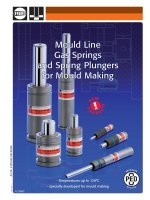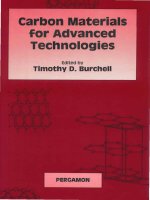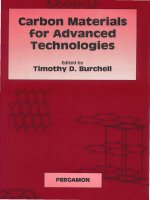Tài liệu Edited by-I -Timothy D. Burchell Carbon Materials for Advanced Technologies doc
Bạn đang xem bản rút gọn của tài liệu. Xem và tải ngay bản đầy đủ của tài liệu tại đây (14.05 MB, 566 trang )
Edited
by
-I
-
Timothy
D.
Burchell
*
Carbon Materials
for
Advanced
Technologies
Carbon Materials
for
Advanced
Technologies
Edited
by
Timothy
D.
Burchell
Oak
Ridge,
National Laboratory
Oak
Ridge,
TN
37831 -6088
U.S.A.
1999
PERGAMON
An Imprint
of
Elsevier Science
Amsterdam
-
Lausanne
-
New
York
-
Oxford
-
Shannon
-
Singapore
-
Tokyo
ELSEVIER
SCIENCE
Ltd
The Boulevard, Langford Lane
Kidlington, Oxford
0x5
IGB,
UK
@
1999
Elsevier Science
Ltd.
All rights reserved.
This
work
is
protected under copyright
by
Elsevier science, and
the
following terms and conditions
apply
to
its
use:
Photocopying
Slngle photocopies of single chapters may be made for personal use
as
allowed
by
national copyright laws.
Permission of the Publisher and payment of
a
fee
is
required for
all
other photocopying, including
multiple or systematic copying, copying for advertising or promotional purposes, resale, and all forms of
document delivery.
Special
rates
are available for educational institutions
that
wish to make photocopies
for non-profit educational classroom use.
Permissions may be sought
directly
from Elsevier science Rights
&
Permissions Department,
PO
Box
800,
Oxford
OX5
IDX,
UK;
phone:
(+44)
1865
843830,
fax:
(+44)
1865
853333,
e-mail:
You may also contact Rights
&
Permissions directly through Elsevier's home
page
(),
selecting
first
'Customer Support', then 'General Information', then 'Permissions Query Form'.
In
the
USA,
users may
clear
permissions and make payments through
the
Copyright Clearance Center, Inc.,
222
Rosewood Drive, Danvers,
MA
01923,
USA
phone:
(978)
7508400,
fax:
(978)
7504744,
and in
the
UK
through
the
Copyright Licensing Agency
Rapid
clearance Service
(CLARCS),
90
Tottenham court Road,
London
WIP
OLP,
UK;
phone:
(+44)
171
631
5555;
fax:
(+44)
171
631
5500.
other
countries may have
a
local
reprographic rights agency for payments.
Derivative Works
Tables
of contents may be reproduced for internal circulation, but Permission of Elsevier Science
is
required for external
resale
or distribution of such material.
Permission
of
the Publisher
is
required for
all
other derivative works, including compilations and
translations.
Electronic storage or usage
Permission of the Publisher
is
required to store or use electronically any material contained in
this
work,
including any chapter or
part
of
a
chapter.
Except
as
outlined above, no
part
of
this
work may be reproduced, stored in
a
retrieval system or
transmitted in any form or
by
any means, electronic, mechanical, photocopying, recording or otherwise,
without prior written permission of the Publisher.
Address permissions requests to: Elsevier Science
Rights
&
Permissions Department,
at
the
mail,
fax
and
e-mail addresses noted above.
Notice
No responsibility
is
assumed
by
the
Publisher for any injury and/or damage to persons or property
as
a
matter of Products liability, negligence or otherwise, or from any use or operation of any methods,
Products, instructions or ideas contained in the material herein. Because
of
rapid
advances in the medical
sciences, in particular, independent verification of diagnoses and drug dosages should
be
made.
First
edition
1999
Library of congress Cataloging
in
Publication Data
A catalog record from the Library of Congress has been applied for.
British
Library cataloguing
in
publication Data
A catalogue record from the British Library has been applied for.
ISBN
0-08-042683-2
@
The paper used
in
this
Publication meets the requirements of ANSI/NISO
239.48-1992
(Permanence of Paper).
Printed
in
The Netherlands.
Contents
Gon~ibutors
xi
Acknowledgments
xiii
pref~ce
xv
1
Structure
and Bonding in
Carbon
Materials
P
Brian
Me
E
naney
1
Introduction
1
2 Crystalline
Forms
of
Carbon
3
3
The
Phase and Transition Diagram for Carbon
12
4
CarbonFilms
14
5
Carbon Nanoparticles
18
6
Engineering Carbons
20
7 ConcludingRemarks
28
8 Acknowledgments
29
9
References
29
2
Fullerenes
and
Nanotubes
39
Mildred
S
.
Dresselhaus
.
Peter
C
.
Eklund
and
Gene Dresselhaus
1 Introduction
35
2
4
Applications
84
5
Acknowledgments
87
6 References
87
Fullerenes and Fullerene-based Solids
37
3
Carbon Nanotubes
61
3
Active Carbon Fibers
95
Timothy
J.
Mays
1 Introduction
95
2
Background
96
3
5
Acknowledgments
111
6
References
111
Applications
of
Active Carbon Fibers
101
4
ConcludingRemarks
110
vi
4
High Performance Carbon Fibers
119
Dan D
.
Edie and
John
J
.
McHugh
Introduction
119
Processing Carbon Fibers from Polyacrylonitrile
119
High Performance Carbon Fibers from Novel Precursors
133
Carbon Fiber Property Comparison
133
Current Areas for High Performance Carbon Fiber Research
134
Summary and Conclusions
135
References
135
Carbon Fibers from Mesophase Pitch
123
5
Vapor Grown Carbon Fiber Composites
139
Max
L
.
Lake and Jyh-Ming Ting
Introduction
139
CurrentForms
142
Fiberproperties
144
Composite Properties
146
Potential Applications
158
Manufacturing Issues
160
Conclusions
164
References
165
6
Porous Carbon Fiber-Carbon Binder Composites
169
Timothy
D
.
Burchell
Introduction
169
Manufacture
169
Carbon Bonded Carbon Fiber
173
Damage Tolerant Light Absorbing Materials
181
Summary
and Conclusions
200
Acknowledgments
201
References
201
Carbon Fiber Composite Molecular Sieves
183
7
Coal-DerivedCarbons
205
Peter
G
.
Stansberry.
John
W
.
Zondlo and Alfred
H
.
Stiller
1
Review of Coal Derived Carbons
205
2 SolventExtractionofCoal
211
3 Preparation and Characteristics
of
Cokes Produced
from
Solvent
Extraction
223
4 Preparation and Evaluation of Graphite from Coal-Derived
Feedstocks
229
5
Summary
233
6 Acknowledgments
233
7
References
233
8
Activated Carbon for Automotive
Applications
235
Philip
J.
Johnson.
David
J.
Setsuda and Roger
S
.
Williams
Background
235
Activated Carbon
239
Vehicle Fuel Vapor Systems
244
Adsorption
246
Carbon Canister Design
252
Application of Canisters in Running
Loss
Emission Control
257
Application
of
Canisters
in
ORVR
Control
263
Summary
and Conclusions
265
References
266
9
Adsorbent Storage for Natural Gas Vehicles
269
Terv
L
.
Cook.
Costa Komodromos. David
F
.
Quinn and
Steve Ragun
1
Introduction
269
2 Storage of Natural Gas
274
3 Adsorbents
280
4 Adsorbent Fill-Empty Testing
293
5 GuardBeds
294
6 Summary
298
7
References
299
vlll
10
Adsorption Refrigerators and Heat Pumps
303
Robert
E
.
Critoph
1
3
4
5
7
References
339
Why Adsorption Cycles?
303
2 The Basic Adsorption Cycle
306
Basic Cycle Analysis and Results
313
Choice of Refrigerant
.
Adsorbent Pairs
319
Improving Cost Effectiveness
322
6
Summary and Conclusions
339
11 Applications
of
Carbon in Lithium-Ion Batteries
341
Tao Zheng and Jeff Dahn
1
.
Introduction
341
2
.
Useful Characterization Methods
347
3
.
GraphiticCarbons
353
4
.
Hydrogen-Containing Carbons
from
Pyrolyzed Organic Precursors 358
5
.
Microporous Carbons from Pyrolyzed Hard-Carbon Precursors
375
6
.
Carbons Used in Commercial Applications
384
7
.
References
385
12
Fusion Energy Applications
389
Lance
L
.
Snead
1
.
Introduction
389
2
.
3
.
Irradiation Effects
on
Thennophysical Properties
of
Graphite and
Carbon Fiber Composites
400
4
.
Plasma Wall Interactions
412
5
.
Tritium Retention
in
Graphite
420
6
.
Summary
and Conclusions
424
7
.
Acknowledgments
424
8
.
References
425
The Advantages of Carbon
as
a
Plasma-Facing Component
394
ix
13
Fission Reactor Applications
of
Carbon
429
Timothy
D
.
Burchell
1
. The Role
of
Carbon Materials in Fission Reactors
429
2
.
Graphite Moderated Power Producing Reactors
438
3
.
Radiation Damage in Graphite
458
4
. RadiolyticOxidation
469
5
.
473
6
.
Summary
and Conclusions
477
7
. Acknowledgments
478
8
. References
478
Other Applications
of
Carbon in
Fission
Reactors
14
Fracture in Graphite
485
Glenn
R .
Romanoski
and
Timothy
D
.
Burchell
1
.
2
.
3
.
4 .
5
.
6
.
7
.
8
.
9
.
Introduction
485
Studies and Models
of
Fracture Processes
in
Graphite
486
Linear Elastic Fracture Mechanics Behavior of Graphite
4911
Elastic-plastic Fracture Mechanics Behavior of Graphite
497
Fracture Behavior
of
Small Flaws in Nuclear Graphites
503
Summary and Conclusions
530
Acknowledgments
531
References
532
The Burchell Fracture Model
515
Index
539
xi
Contributors
Timothy
D.
Burchell,
Metals and Ceramics Division, Oak Ridge National
Laboratory, Oak Ridge, Tennessee 37831, USA
Terry
L.
Cook, Atlanta Gas Light Company, P.O. Box 4569, Atlanta, Georgia
30302, USA
Robert
E.
Critoph,
Department
of
Engineering, University
of
Warwick,
Coventry
CV4 7AL, United Kingdom
Jeff Dah,
Department of Physics, Dalhousie University,
Hulga,
Nova Scotia
B3H 3J5, Canada
Gene Dresselhaus,
Francis Bitter Magnet Laborato
ry,
Massachusetts Institute
of
Technology, Cambridge, Massachusetts 02139,
USA
Mildred
S.
Dresselhaus,
Department of Electrical Engineering and Computer
Science and Department
of
Physics, Massachusetts Institute
of
Technology,
Cambridge, Massachusetts 02139, USA
Dan D. Edie,
Department
of
Chemical Engineering, Clemson University,
Clemson, South Carolina 29634, USA
Peter
C.
Eklund,
Department
of
Physics and Astronomy and Center for Applied
Energy Research, University
of
Kentucky, Lexington, Kentucky 40506, USA
Philip
J.
Johnson,
Ford Motor Company, Automotive Components Division,
Schaefer Court
II,
14555 Rotunda Drive, Dearborn, Michigan 48120,
USA
Costa Komodromos,
Gas Research Centre, British Gas, Ashby Road,
Loughborough, Leicestershire LEI
1
36U, United Kingdom
Max
L.
Lake,
Applied Sciences,
Inc.
I41 West Xenia Avenue, Cederville, Ohio
45314,
USA
Timothy
J.
Mays, School
of
Materials Science and Engineering, University of
Bath, Bath BA2 7AY, United Kingdom
Brian
McEnaney,
School
of
Materials Science and Engineering, University of
Bath, Bath BA2 7AY, United Kingdom
John
J.
McHugh,
Hexcel Corporation, Hercules Research Center, Wilmington,
Delaware
19808,
USA
David
F.
Quinn,
Royal Military College, Kingston, Ontario K7K 5L0, Canada
Steve
Ragan,
Sutclifle Speakman Carbons Ltd., Lockett Road, Ashton in
Make@eld, Lancashire wN4
&DE,
United Kingdom
Glenn
R. Romanoski,
Metals and Ceramics Division, Oak Ridge National
Laboratory, Oak Ridge, Tennessee 37831, USA
David
J.
Setsuda,
Ford Motor Company, Automotive Components Division,
Schaefer Court
II,
14555 Rotunda Drive, Dearborn, Michigan 48120, USA
Lance
L.
Snead,
Metals and Ceramics Division, Oak Ridge National
Laboratory, Oak Ridge, Tennessee 37831, USA
xii
Peter G.
Stansberry,
Department
of
Chemical Engineering, West Virginia
University, Morgantown, West Virginia 26502,
USA
Alfred
H.
Stiller,
Department
of
Chemical Engineering, West Virginia
University, Morgantown, West Virginia 26502,
USA
Jyh-Ming
Ting,
Department
of
Materials Science and Engineering, National
Cheng Kung Universiv, Tainan, Taiwan
Roger
S.
Williams,
Westvaco Corporation, Washington Street, Covington,
Virginia 24426,
USA
Tao
Zheng,
Department
of
Physics, Simon Frmer University, Burnaby, British
Columbia
VA5
1S6,
Canada
John
W.
Zondlo,
Department ofChemica1 Engineering, West Virginia
University, Morgantown, West Virginia 26502,
USA
Xlll
Acknowledgments
I
wish
to acknowledge the cooperation and patience of the contributing authors, the
assistance
of
my colleagues
with
the
task
of
refereeing the chapter manuscripts, the
forbearance and understanding
of
the book's publishers, and the contribution
of
Dr.
Frederick
S.
Baker
in
soliciting chapters
in
the area
of
activated carbons.
Finally,
it
is
appropriate that
I
acknowledge my wife Lynne, whose support and
encouragement were essential ingredients in the completion of
this
book.
Timothy
D.
Burchell.
xv
Preface
In
1994
the
Oak
Ridge National Laboratory hosted an American Carbon Society
Workshop entitled “Carbon Materials for Advanced Technologies”. The
inspiration for
this
book came fiom that workshop. By late
1995
a suitable group
of contributors had been identified such that the scope of this book would be
sufficiently broad to make a useful contribution to the literature.
Carbon
is
a truly remarkable element which can exist as one of several allotropes.
It is found abundantly in nature as coal or as natural graphite, and much less
abundantly as diamond. Moreover, it is readily obtained from the pyrolysis
of
hydrocarbons such as resins and pitches, and can be deposited from the vapor phase
by cracking hydrocarbon rich gases. In its various allotropic forms carbon has
quite remarkable properties. Diamond possesses the highest thermal conductivity
known
to
man
and is prized as a gem stone. Both of these attributes result
from
the
high degree of crystal perfection and bond strength
in
the diamond lattice. Graphite
possesses extreme anisotropy in the bond energies of its crystal lattice, resulting in
highly anisotropic physical properties. The most recently discovered allotrope
of
carbon, C,, or Buclctnmsterfullerene,
has
been the subject of extensive research, as
have the related carbon nanotubes and nanostructures.
Engineered carbons take many forms. For example, cokes, graphites, carbon and
graphite fibers, carbon fiber
-
carbon matrix composites, adsorbent carbons and
monoliths, glassy carbons, carbon blacks, carbon films and diamond llke
films,
Many
of
these engineered carbon forms are discussed in this book, especially with
respect to their applications
in
technologically advanced systems. Moreover, this
book contains accounts of research into the uses of novel carbons. Modern day
applications of carbon materials are numerous. Indeed, the diversity of carbon
applications are truly astounding, and range from the mundane
(e.g.,
commodity
adsorbent carbons or carbon black), to the exotic
(e.g.,
hgh modulus carbon fibers
that enable the lightweight stiff composite structures used in airfiames and
spacecraft).
Chapter
1
contains a review of carbon materials, and emphasizes the structure
and
chemical bonding
in
the various forms of carbon, including the four allotropes
diamond, graphite, carbynes, and the fullerenes.
In
addition, amorphous carbon
and diamond
films,
carbon nanoparticles, and engineered carbons are discussed.
The most recently discovered allotrope of carbon,
i.e.,
the fullerenes, along with
carbon nanotubes, are more fully discussed in Chapter
2,
where their structure-
property relations are reviewed in the context of advanced technologies for carbon
based materials. The synthesis, structure, and properties of the fullerenes and
XVi
nanotubes, and modification of the structure and properties through doping, are
also reviewed. Potential applications of this new family of carbon materials are
considered.
Detailed accounts of fibers and carbon-carbon composites can be found in several
recently published books [l-51. Here, details
of
novel carbon fibers and their
composites are reported The manufacture and applications of adsorbent carbon
fibers are discussed in Chapter 3. Active carbon fibers are an attractive adsorbent
because their small diameters (typically
6-20
pm) offer a kinetic advantage over
granular activated carbons whose dimensions are typically 1-5
mm.
Moreover,
active carbon fibers contain a large volume of mesopores and micropores. Current
and emerging applications of active carbon fibers are &cussed. The manufacture,
structure and properties of high performance fibers are reviewed in Chapter
4,
whereas the manufacture and properties
of
vapor grown fibers and their composites
are reported in Chapter 5. Low density (porous) carbon fiber composites have
novel properties that make them uniquely suited for certain applications. The
properties and applications of novel low density composites developed at
Oak
Ridge National Laboratory are reported in Chapter
6.
Coal is an important source of energy and an abundant source of carbon. The
production of engineering carbons and graphite from coal via a solvent extraction
route is described in Chapter
7.
Coal derived carbons and graphites are fist
reviewed and the solvent extraction of coal using N-methyl pyrrolidone
is
described. The characteristics of cokes and graphites derived from solvent
extracted pitches and feedstocks are reported. The modification of the calcined
cokes by blending the extracted pitches, andor by hydrogenation of the pitch, and
subsequent control of graphite artifact properties are discussed.
Applications of activated carbons are discussed in Chapters
8-10,
including their
use in the automotive arena as evaporative loss emission traps (Chapter
8),
and in
vehicle natural gas storage tanks (Chapter
9).
The use of evaporative loss emission
traps has been federally mandated in the
U.S.
and Europe. Consequently, a
significant effort has been expended to develop a carbon adsorbent properly
optimized for evaporative loss control, and to design the on board vapor collection
and disposal system. The manufacture of activated carbons, and their preferred
characteristics for fuel emissions control are discussed in Chapter
8,
along with the
essential features of a vehicle evaporative
loss
emission control system.
The use of activated carbons as a natural gas storage medium for vehicles is
attractive because the gas may be stored at significantly lower pressures in the
adsorbed state (3.5
-
4.0
MPa) compared to pressurized natural gas (20 MPa), but
with comparable storage densities. The development of an adsorbed natural gas
storage system, and suitable adsorbent carbons, including novel adsorbent carbon
xvii
monoliths capable of storing >150
VN
of
natural gas, are reported
in
Chapter
9.
Moreover, the function and use of a guard bed to prevent deterioration
of
the
carbon adsorbent with repeated fii-empty cycling is discussed.
The application of activated carbons in adsorption heat pumps and reftigerators is
discussed
in
Chapter
10.
Such arrangements offer the potential for increased
efficiency because they utilize a primary fuel source for heat, rather than use
electricity, which
must
first be generated and transmitted to a device to provide
mechanical energy. The basic adsorption cycle is analyzed and reviewed, and the
choice of refiigerant-adsorbent pairs discussed. Potential improvements
in
cost
effectiveness are detailed, including the use of improved adsorbent carbons,
advanced cycles,
and
improved heat transfer in the granular adsorbent carbon beds.
Chapter
11
reports the use
of
carbon materials in the fast growing consumer
electronics application
of
lithium-ion batteries. The principles
of
operation
of
a
lithumion battery and the mechanism of Li insertion are reviewed. The duence
of the structure of carbon materials
on
anode performance is described.
An
extensive study of the behavior of various carbons
as
anodes in Li-ion batteries is
reported. Carbons used
in
commercial Li-ion batteries are briefly reviewed.
The role of carbon materials
in
nuclear systems
is
discussed in Chapters
12
and
13,
where fusion device and fission reactor applications, respectively, are reviewed.
In
Chapter
12
the major technological issues for the utilization of carbon as a
plasma facing material are discussed
in
the context of current and future fusion
tokamak devices. Problems such as surface sputtering, erosion, radiation enhanced
sublimation, radiation damage, and tritium retention are addressed. Carbon
materials have been used
in
fBsion reactors for
>50
years. Indeed the fist nuclear
reactor was a graphite “pile” [6]. The essential design features of graphite
moderated reactors, (including gas-, water- and molten salt-cooled systems) are
reviewed
in
Chapter
13,
and reactor environmental effects such as radiation
damage and radiolytic corrosion are discussed. The forms of carbon used
in
fission
reactors (graphite, adsorbent carbon, carbon-carbon composites, pyrolytic graphite,
etc.) are reviewed and their functions described.
Graphite is a widely used commodity.
In
addition to it nuclear role, graphite is
used
in
large quantities by the steel industry as arc electrodes in remelting furnaces,
for metal casting molds by the
foundry
industry, and
in
the semi-conductor industry
for furnace parts and boats. Graphite is a brittle ceramic, thus its fracture behavior
and the prediction
of
failure are important
in
technological applications. The
fracture behavior of graphite
is
discussed in qualitative and quantitative terms in
Chapter
14.
The applications of Linear Elastic Fracture Mechanics and Elastic-
Plastic Fracture Mechanics to graphite
are
reviewed and a study
of
the role of
small
flaws
in
nuclear graphites
is
reported. Moreover, a mathematical model
of
fracture
xviii
is reported and its performance discussed.
Clearly, not all forms of carbon material, nor all the possible applications thereof,
are discussed
in
this
book. However, the application
of
carbon materials
in
many
advanced technologies are reported here. Carbon
has
played an important role in
mankind's technological and social development. In the form of
charcoal
it was
an essential ingredient of gunpowder! The industrial revolution
of
the
18* and 19"
centuries was powered by steam raised from the burning of coal! New applications
of
carbon materials
will
surely be developed
in
the future.
For example, the
recently discovered carbon nanostructures based on
C60
(closed cage molecules,
tubes and tube bundles), may be the foundation
of
a new and significant
applications area based
on
their superior mechanical properties, and novel
electronic properties.
Researching carbon materials, and developing new applications,
has
proven to be
a complex and exciting topic
that
will
no
doubt continue to engage scientists and
engineers for may years
to
come.
References.
1.
Donnet, J-B. and Bansal,
R.C.
Carbon Fibers,
2nd
Edition, Marcel Dekker,
Inc., New York. 1990.
2.
Thomas, C.R., ed.
Essentials
of
Carbon-Carbon Composites,
Royal Society
of
Chemistry, UK. 1993
3. Buckley, J.D. and Edie,
D.D.
Carbon-Carbon Materials and Composites,
Noyes Publications, Park Ridge, NJ. 1993.
4.
Savage,
G.
Carbon-Carbon Composites,
Chapman
&
Hall, London, 1993.
5. D.L. Chung,
Carbon Fiber Composites,
Pub. Butterworth-Heinemann,
Newton,
MA.
1994.
6.
E.
Fermi, Experimental production of a divergent chain reaction,
Am.
J.
Phys.,
1952,20(9),
536
538.
Timothy. D. Burchell
1
CHAPTER
1
Structure and Bonding in Carbon Materials
BRIAN
McENANEY
Department
of
Materials Science
&
Engineering
University
of
Bath
Bath,
BA2
7AY
United Kingdom
1
Introduction
The extraordinary ability of the chemical element carbon to combine with itself
and other chemical elements in different ways is the basis of organic chemistry
and of life. This chemical versatility also gives rise to a rich diversity of
structural forms of solid carbon. This introductory chapter is an attempt to
survey the very wide range of carbon materials that is now available with
emphasis on chemical bonding and microstructure. The materials reviewed
include: (i) crystalline forms of carbon: diamond, graphite, Fullerenes and
carbynes; (ii) amorphous carbon
films
and diamond
films;
(iii) carbon
nanoparticles, including carbon nanotubes; (iv) engineering carbons with more-
or-less disordered microstructures based on that of graphite that are the main
focus of this book.
1,
I
Bonding between carbon atoms
Here, the bonding between carbon atoms is briefly reviewed; fuller accounts can
be found in many standard chemistry textbooks, e.g., [l]. The carbon atom
[ground state electronic configuration
(
ls2)(2s22p,2py)] can form sp3, sp2 and
sp' hybrid bonds as a result of promotion and hybridisation. There are four
equivalent 2sp3 hybrid orbitals that are tetrahedrally oriented about the carbon
atom and can form four equivalent tetrahedral
o
bonds by overlap with orbitals
of other atoms. An example is the molecule ethane, C,H,, where a Csp3-Csp3
(or
C-C)
(T
bond is formed between two C atoms by overlap of sp3 orbitals, and
three Csp3-H1
s
o
bonds are formed on each C atom, Fig. 1,
A
1.
A
second type of hybridisation of the valence electrons in the carbon atom can
occur to form three 2spz hybrid orbitals leaving one unhybridised 2p orbital.
2
The sp2 orbitals are equivalent, coplanar and oriented at 120" to each other and
form
cs
bonds by overlap with orbitals of neighbouring atoms, as in the molecule
ethene, C,H,, Fig.
1,
A2.
The remaining p orbital on each C atom forms a
7c
bond by overlap with the p orbital from the neighbouring C atom; the bonds
formed between
two
C
atoms
in
this
way are represented as Csp"Csp2, or
simply as C=C.
AI.
ethane
A2,
ethene
A3,
&go
RI,
benzene
B2,
coronene
83,
ovalene
Fig.
1.
Some molecules
with
different
C-C
bonds.
Al,
ethane,
C,H,
(sp');
A2,
ethene,
C,H,
(sp');
A3,
ethyne,
C,H,
(sp');
B1,
benzene,
CJ16
(aromatic);
B2,
coronene,
C,,H,,;
B3,
ovalene,
C,,H,,.
In the third type of hybridisation of the valence electrons
of
carbon,
two
linear
2sp' orbitals are formed leaving
two
unhybridised 2p orbitals. Linear
(T
bonds
are formed by overlap of the
sp
hybrid orbitals with orbitals of neighbouring
atoms, as in the molecule ethyne (acetylene) C2H2, Fig. 1,
A3.
The unhybridised
p orbitals of the carbon atoms overlap to
form
two
n
bonds; the bonds formed
between two C atoms in this way are represented as Csp~Csp, or simply as C=C.
It is also useful to consider the aromatic carbon-carbon bond exemplified by the
prototypical aromatic molecule benzene, C6&. Here, the carbon atoms are
arranged
in
a regular hexagon which is ideal for the formation of strain-free spz
cs
bonds.
A
conventional representation of the benzene molecule as a regular
hexagon
is
in Fig. 1,
B
1. The ground state
n
orbitals in benzene are all bonding
orbitals and are fully occupied and there is a large delocalisation energy that
contributes to the stability of the compound. The aromatic carbon-carbon bond
is denoted as Car~Car. Polynuclear aromatic hydrocarbons consist
of
a number,
n,
of
fused benzene rings; examples are coronene,
C,,H,,,
(n
=
7)
and ovalene,
C,,H,,, (n
=
lo), Fig.
1
B2,
B3,
where delocalisation of
n
electrons extends over
the entire molecule. Note that the C:H atomic ratio in polynuclear aromatic
hydrocarbons increases with increasing
n.
Dehydrogenative condensation
of
polynuclear aromatic compounds
is
a feature of the carbonisation process and
eventually leads to an extended hexagonal network
of
carbon atoms,
as
in
the
basal plane
of
graphite (see Sections 2.2 and
6.1).
3
For carbon-carbon bonds the mean bond enthalpy increases and bond length
decreases with increasing bond order, Table 1. When considering bond lengths
in disordered carbon materials, particularly those containing significant amounts
of heteroelements,
it
is useful
to
note that the values in Table
1
are mean, overall
values. Carbon-carbon bond lengths depend upon the local molecular
environment. Table
2
lists some values of carbon-carbon bond lengths obtained
from
crystals of organic compounds. In general, bond length decreases as the
bond order of adjacent carbon-carbon bonds increases.
Table
1.
Some
properks
of
carbon-carbon bonds
Bond
Bond
order Bond
length Mean bond enthalpy
csp3-csp3 1 153.0 348
CarZCar
1.5
138.4 518
CSp’=CspZ
2
132.2 612
csp=csp 3 118.1 838
/Pm
/(kJ
rno1-l)
Table
2.
Carbon-carbon bond lengths
in
organic compounds
[Z].
Carbon-carbon bond Sub-structure Bond length/pm
csp3-csp3 -c*-c*- 153.0
Csp3-Car -C*-Carz 151.3
Csp3-Csp2 -c*-c=c-
150.7
Csp3-Csp’ -c*-c=c-
149.0
csp2-car C=C-Car= 148.3
csp2-csp2 c=c-c=c 146.0b
Csp?-Csp’ c=c-c=c 143.1
Mdtiple
bonds
CarYCar (phenyl) c*-cg-c* 139.7
csp2=csp2 c*-c=c-c* 131.6
Single
bonds
+a
Csp’=Csp’ C*-CEC-C* 118.1
a,
points
to
the
relevant
carbon-carbon bond; b.
overall value
2
Crystalline
Forms
of
Carbon
The commonest crystalline forms
of
carbon, cubic diamond and hexagonal
graphite, are classical examples
of
allotropy that are found in every chemistry
textbook. Both diamond and graphite also exist in
two
minor crystallographic
forms: hexagonal diamond and rhombohedral graphite.
To
these must be added
carbynes and Fullerenes, both
of
which are crystalline carbon
forms.
Fullerenes
are sometimes referred to as the third allotrope
of
carbon. However, since
Fullerenes were discovered more recently than carbynes, they are
4
chronologically the fourth crystalline allotrope
of
carbon. Crystalline Fullerenes
are now commercially-available chemicals and their crystal structures and
properties have been extensively studied. By contrast, convenient methods for
mass
production of pure carbynes have not yet been discovered. Consequently,
carbynes have not been
as
extensively characterised as other forms
of
carbon.
The structures and chemical bonding of these crystalline forms
of
carbon are
reviewed
in
this
section.
2.1
Diamond
Diamond
is
an important commodity as a gemstone and as an industrial material
and there are several excellent monographs on the science and technology of
this
material
[3-51.
Diamond
is
most frequently found in a cubic form in which
each carbon atom is linked to four other carbon atoms by
sp3
0
bonds
in
a
strain-free tetrahedral array, Fig.
2A.
The crystal structure is zinc blende
type
and the C-C bond length is 154 pm. Diamond also exists
in
an hexagonal form
(Lonsdaleite) with a Wurtzite crystal structure and
a
C-C bond length
of
152 pm.
The crystal density
of
both types
of
diamond
is
3.52 g-~rn-~.
A
B
Fig.
2.
The
crystal structures
of:
A,
cubic diamond;
B,
hexagonal graphite
Natural diamonds used for jewellery and for industrial purposes have been
mined for centuries. The principal diamond mining centres are
in
Zaire, Russia,
The Republic of South
Africa,
and Botswana. Synthetic diamonds are made by
dissolving graphite in metals and crystallising diamonds at high pressure (12-15
GPa) and temperatures in the range 1500-2000
K
[6];
see section
3.
More
recently, polycrystalline diamond
films
have been made at low pressures by









